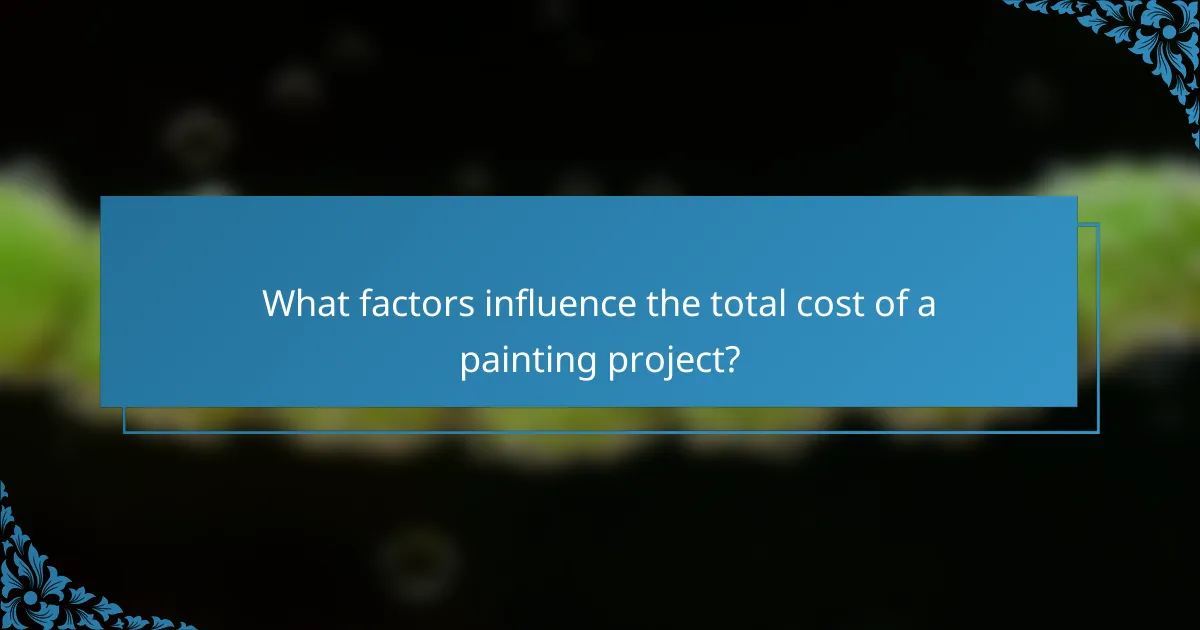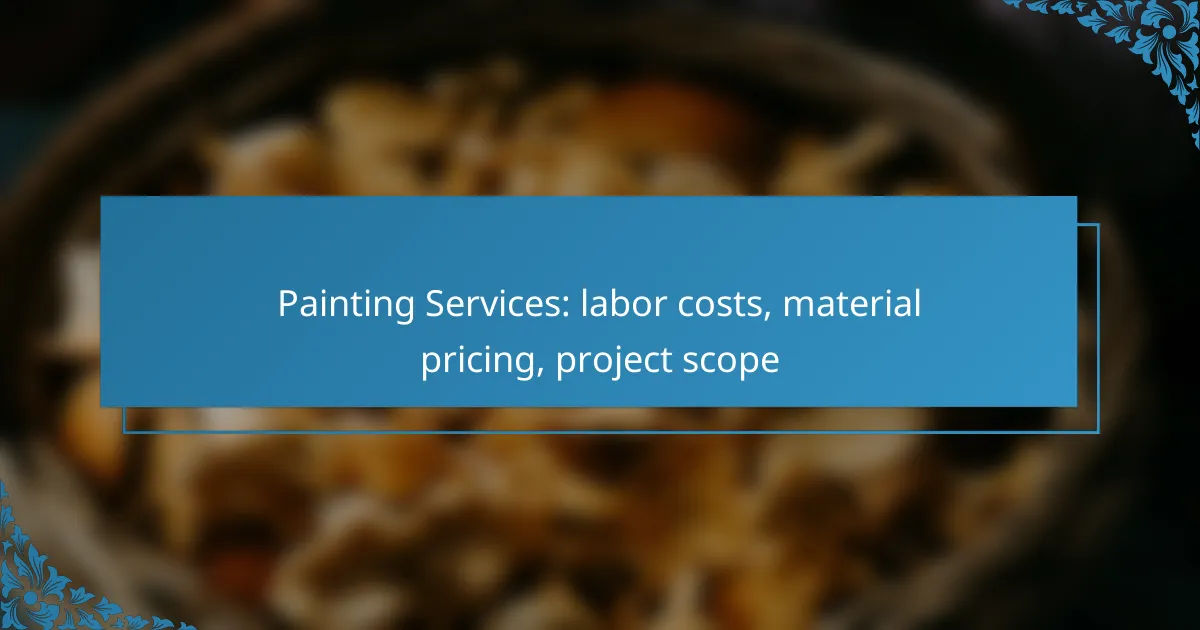When considering painting services, it’s essential to understand the various factors that influence costs, including labor rates and material pricing. In Australia, labor costs typically range from AUD 40 to AUD 70 per hour, depending on the painter’s experience and project complexity. Additionally, material costs can vary widely, with paint prices ranging from a few dollars to over a hundred dollars per gallon. Accurately estimating the project scope is crucial for determining overall expenses, taking into account the area to be painted and the condition of the surfaces.

What are the average labor costs for painting services in Australia?
The average labor costs for painting services in Australia typically range from AUD 40 to AUD 70 per hour. Factors such as the painter’s experience, project complexity, and location can influence these rates significantly.
Hourly rates for professional painters
Hourly rates for professional painters in Australia generally fall between AUD 40 and AUD 70. Experienced painters or those with specialized skills may charge higher rates, while less experienced painters might offer lower prices to attract clients.
It’s common for painters to provide a quote that includes both labor and materials, so it’s essential to clarify whether the hourly rate covers just labor or if it includes other costs.
Factors affecting labor costs
Several factors can affect labor costs for painting services. The complexity of the project, such as the type of surfaces being painted and the number of coats required, can lead to variations in pricing.
Additionally, geographic location plays a significant role; urban areas may have higher labor costs compared to rural regions due to demand and cost of living. Seasonal factors, like weather conditions, can also impact the availability of painters and their rates.
Cost comparison by region
Labor costs for painting services can vary widely across Australia. In major cities like Sydney and Melbourne, hourly rates may be at the higher end of the spectrum, often exceeding AUD 70 per hour. In contrast, regional areas might see rates closer to AUD 40.
For a clearer comparison, here are some average hourly rates by region:
- Sydney: AUD 60 – AUD 80
- Melbourne: AUD 55 – AUD 75
- Brisbane: AUD 50 – AUD 70
- Perth: AUD 50 – AUD 65
- Adelaide: AUD 45 – AUD 60

What is the typical material pricing for painting projects?
The typical material pricing for painting projects can vary significantly based on the type of paint and additional supplies required. Generally, homeowners can expect to spend anywhere from a few dollars to over a hundred dollars per gallon of paint, depending on quality and type.
Cost of paint types (e.g., acrylic, oil-based)
The cost of paint types can range widely. For instance, acrylic paints typically cost between $15 to $50 per gallon, while oil-based paints may range from $20 to $70 per gallon. Higher-end brands or specialty paints, such as those with low VOCs or specific finishes, can exceed these ranges.
When choosing a paint type, consider the surface being painted and the desired finish. Acrylic paints are often preferred for their quick drying time and ease of cleanup, while oil-based paints are valued for their durability and smooth finish.
Pricing for additional materials (brushes, rollers)
In addition to paint, various tools and materials are necessary for a successful painting project. Quality brushes and rollers can cost anywhere from $5 to $30 each, depending on the brand and type. Investing in good-quality tools can significantly affect the final result and ease of application.
Don’t forget to account for other supplies such as painter’s tape, drop cloths, and trays, which can add an additional $20 to $50 to your overall material costs. These items are essential for protecting surfaces and ensuring clean lines.
Bulk purchase discounts
Many suppliers offer bulk purchase discounts, which can help reduce overall material costs for larger projects. Buying paint in larger quantities, such as five-gallon buckets, can often save you 10-20% compared to purchasing individual gallons.
When planning a project, consider estimating your total paint needs accurately to take advantage of these discounts. Additionally, check with local suppliers for any ongoing promotions or loyalty programs that may further reduce costs.

How to estimate the project scope for painting?
Estimating the project scope for painting involves evaluating the total area to be painted, the condition of surfaces, and the complexity of the project. This assessment helps in determining the labor and material costs effectively.
Calculating square footage
To calculate square footage, measure the height and width of each wall and multiply these dimensions. For ceilings and large surfaces, include their area in your total. A common rule of thumb is that one gallon of paint typically covers around 350 to 400 square feet.
When estimating, consider subtracting areas for windows and doors to avoid overestimating paint needs. For example, if a room has 10 square meters of wall space but 2 square meters of windows, you would calculate the paintable area as 8 square meters.
Assessing surface conditions
Surface conditions significantly impact the preparation and materials required for painting. Inspect for issues like peeling paint, cracks, or mold, which may necessitate additional repairs or special primers.
For instance, a smooth, previously painted surface may require less prep work compared to a rough, untreated surface. Be prepared to allocate extra time and materials for surfaces needing extensive repair or cleaning.
Determining project complexity
The complexity of a painting project can vary based on factors like the number of colors, the need for detailed work, or the height of the surfaces. Projects involving intricate designs or multiple colors will require more planning and labor.
For example, painting a single color on a flat wall is straightforward, while painting a room with crown molding and accent walls may increase both time and costs. Always factor in these complexities when estimating your project scope to avoid unexpected expenses.

What factors influence the total cost of a painting project?
The total cost of a painting project is influenced by several key factors including the size of the area, the type of paint selected, and the accessibility and preparation requirements. Understanding these elements can help you budget effectively and avoid unexpected expenses.
Size of the area to be painted
The size of the area directly impacts labor and material costs. Larger spaces require more paint and time, leading to higher expenses. For example, painting a small room may cost a few hundred dollars, while a larger living area could run into the low thousands.
When estimating costs, consider the square footage. A rough rule of thumb is that one gallon of paint typically covers about 350 square feet. This can help you calculate how much paint you’ll need and the associated costs.
Type of paint selected
The type of paint you choose can significantly affect the overall cost of your project. Higher-quality paints often come with a higher price tag but can offer better coverage and durability. For instance, premium paints may cost 20-50% more than standard options but might require fewer coats.
Additionally, specialty paints, such as those designed for high-moisture areas or low-VOC options for better indoor air quality, can also increase costs. Weigh the benefits of these options against your budget to make an informed decision.
Accessibility and preparation requirements
Accessibility of the area to be painted can influence labor costs. If the space is difficult to reach or requires extensive preparation, such as moving furniture or repairing walls, this can add to the overall expense. For example, a room with high ceilings may require scaffolding, increasing labor time and costs.
Proper preparation is essential for a quality finish. Ensure that surfaces are clean and primed, as neglecting this step can lead to poor adhesion and the need for additional coats. Budget for preparation time and materials to avoid surprises during the project.

What are the key considerations when hiring a local painter?
When hiring a local painter, it’s essential to evaluate their qualifications, customer feedback, and the terms of their warranty and service agreements. These factors will help ensure you select a reliable professional who meets your project needs and expectations.
Checking qualifications and experience
Verify the painter’s qualifications by checking their licensing and insurance status. A licensed painter typically adheres to local regulations and standards, which can vary by region.
Experience matters too; consider how long they have been in business and whether they specialize in the type of painting you require, such as residential or commercial work. It’s beneficial to ask for examples of previous projects similar to yours.
Reviewing customer testimonials
Customer testimonials provide insight into the painter’s reliability and quality of work. Look for reviews on reputable platforms or ask the painter for references from past clients.
Pay attention to feedback regarding punctuality, professionalism, and the final results. A painter with consistently positive reviews is more likely to deliver satisfactory service.
Understanding warranty and service agreements
Before hiring a painter, clarify the warranty and service agreements they offer. A good warranty typically covers defects in workmanship and materials for a specified period, often ranging from one to five years.
Ensure you understand the terms of service agreements, including what is covered and any conditions that may void the warranty. This knowledge can protect you from unexpected costs after the project is completed.

How do painting permits affect project costs?
Painting permits can significantly influence project costs by adding fees and potential delays. Understanding the types of permits required and their associated costs is essential for accurate budgeting and planning.
Types of permits required in Australia
In Australia, the types of permits required for painting projects can vary by state and municipality. Commonly, a development approval or a building permit may be necessary, especially for larger projects or those involving significant structural changes. Always check local council regulations to determine specific requirements.
For residential properties, minor painting jobs often do not require permits, but commercial projects typically do. It’s crucial to verify whether your project falls under the exempt categories or if a permit is mandatory.
Permit fees and processing times
Permit fees in Australia can range from low tens of AUD for minor works to several hundred AUD for larger projects. Processing times can vary widely, from a few days for straightforward applications to several weeks for more complex cases. Planning ahead can help mitigate delays in your painting schedule.
To avoid unexpected costs, factor in these fees when estimating your overall project budget. Always consult your local council for the most accurate fee structures and timelines.
Impact of local regulations on project scope
Local regulations can significantly impact the scope of your painting project. Restrictions may dictate color choices, materials, and even the timing of work to minimize noise disturbances. Understanding these regulations can help you avoid fines and ensure compliance.
For example, heritage-listed properties often have strict guidelines that must be followed, affecting both the type of paint used and the overall aesthetic. Engaging with local authorities early in the planning stage can provide clarity and help streamline the approval process.
